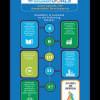SDGs at a crossroads: Can the world meet its targets?

At the United Nations Summit of the Future, which is taking place in New York, US on September 22-23, the progress on the Sustainable Development Goals (SDGs) has taken centre stage in global discussions. Adopted in 2015, the SDGs are a universal call to action to end poverty, protect the planet, and ensure peace and prosperity for all by 2030. However, as the deadline for SDG implementation approaches its final year, the global community finds itself grappling with significant challenges, with progress uneven across regions. Developing countries, in particular, face mounting difficulties in achieving these goals, exacerbated by external shocks such as the pandemic, economic pressure, climate change, and the ongoing geopolitical instability.
A mixed picture of global progress
The global progress on the 17 SDGs has been inconsistent. The UN Sustainable Development Goals Report 2024 highlights a sobering reality: only 17 percent of the SDG targets are on track to meet the 2030 deadline, while about half of them show moderate or minimal progress. More worryingly, progress on more than one-third of the targets has either stalled or regressed. For example, SDG 1, which aims to eradicate poverty in all its forms, has suffered significant setbacks, with the pandemic pushing millions back into extreme poverty. The situation is similar for SDG 2, which targets zero hunger. Global food insecurity has worsened due to conflicts, climate-related disasters and economic slowdowns.
The report also highlights significant progress in some SDG targets. For instance, decline in child mortality, HIV infections and the cost of remittances as well as improvement in access to water, sanitation, energy, and mobile broadband are all encouraging trends. However, it is important to note that the current trajectory of indicators under SDG 3, which focuses on good health and well-being, is not sufficient to meet the targets by 2030, despite most health-related indicators showing positive progress globally. The pandemic has led to setbacks in healthcare services, with millions missing routine vaccinations and a surge in preventable diseases. In education, while SDG 4 aims for inclusive and equitable quality education, school closures during the pandemic have exacerbated learning disparities, particularly in low-income regions.
Climate action, addressed under SDG 13, remains one of the most urgent challenges. Global carbon emissions have continued to rise, and despite growing awareness and initiatives towards renewable energy, the world is not yet on course to limit global warming to 1.5 degrees Celsius above pre-industrial levels. The recent increase in climate disasters, from wildfires to floods, underscores the urgency for enhanced global cooperation to achieve environmental sustainability.
Challenges for the LDCs
Least developed countries (LDCs) and low-income countries face unique challenges in pursuing the SDGs. Economic constraints, political instability and vulnerability to climate change have left many nations struggling to make significant progress. The pandemic has been particularly devastating, reversing years of development gains and exacerbating inequalities across various sectors.
In LDCs, SDG 1 (No Poverty) remains a daunting challenge. These countries have high extreme poverty levels, more evident in rural areas where access to basic services such as healthcare, education and clean water remains limited. Similarly, SDG 2 (Zero Hunger) is far from being achieved, with food insecurity worsened in poor countries by droughts, conflicts, and rising food prices due to global supply chain disruptions.
Climate change is a significant hurdle for developing nations, many of which are disproportionately affected despite contributing the least to global emissions. Countries in South Asia, Africa, and island nations in the Pacific face increased risks of extreme weather events such as floods, cyclones and droughts, threatening food security and livelihoods. The financial and technical capacity to adapt to these climate challenges is often lacking, making the achievement of SDG 13 (Climate Action) highly complex.
Moreover, access to finance remains a critical issue for developing countries in achieving the SDGs. While SDG 17 emphasises the need for global partnerships to mobilise resources, the reality is that financing remains inadequate. The Financing for Sustainable Development Report 2024 (FSDR 2024) estimates SDG financing and investment gaps at between $2.5 trillion and $4 trillion annually, which has ballooned due to pandemic-related economic disruptions. International support and private sector investment have not kept pace with the growing needs of these countries, leaving them struggling to fund crucial infrastructure, education, and healthcare projects.
Health and education are the critical sectors for LDCs
The situation remains dire for LDCs in SDG 3 (Good Health and Well-Being) and SDG 4 (Quality Education). For SDG 3, the progress that has been achieved in combating diseases such as malaria, HIV and tuberculosis is now at risk. These countries also struggled to provide adequate healthcare services in the wake of the pandemic. In many regions, healthcare infrastructures are weak, leading to high maternal and child mortality rates, inadequate vaccination coverage, and a lack of access to essential medicines.
Education is another area where the impact of the pandemic is acutely felt. SDG 4 aims for inclusive and equitable education, but in many countries, particularly in South Asia and Sub-Saharan Africa, millions of children remain out of school. The digital divide has worsened this issue, as many students in low-income regions lack access to online learning resources, which were vital during the pandemic. The long-term impact on human capital development could be devastating, as millions of children face a lifetime of reduced opportunities due to loss of learning.
Role of global cooperation in moving forward
Intensified global cooperation is needed to accelerate progress in the SDGs, especially in LDCs. One of the key focuses of the summit is on building stronger global partnerships, as emphasised by SDG 17 (Partnerships for the Goals). These countries require increased financial support, technology transfer, and capacity-building efforts from more developed nations. There is also a pressing need for reforming global financial institutions to ensure that low-income countries can access affordable financing for sustainable development projects.
Addressing climate change will also require global solidarity. Developed countries must sustain their commitments to provide $100 billion annually in climate financing to help developing countries mitigate and adapt to climate impacts. Without this support, many vulnerable nations will struggle to achieve sustainable development in the face of worsening climate conditions.
In addition to financial and technical support, global leaders must address the inequalities within and between countries that are hindering SDG progress. This includes promoting fair trade policies, reducing debt burdens on developing nations, and ensuring that the benefits of technological advancements reach those most in need.
The world is at a critical juncture as it assesses the overall SDG progress. LDCs, in particular, face a confluence of challenges that require urgent attention, including economic constraints, climate vulnerability and widening inequalities. The UN Summit of the Future offers a vital opportunity for nations to recommit to the SDGs and to foster greater international cooperation in addressing these challenges. With only about six years left to meet the SDGs, the next few years will be crucial in determining whether the world can achieve a sustainable and equitable future for all.
Dr Fahmida Khatun is executive director at the Centre for Policy Dialogue (CPD) and non-resident senior fellow at the Atlantic Council.
Views expressed in this article are the author's own.
Follow The Daily Star Opinion on Facebook for the latest opinions, commentaries and analyses by experts and professionals. To contribute your article or letter to The Daily Star Opinion, see our guidelines for submission.

 For all latest news, follow The Daily Star's Google News channel.
For all latest news, follow The Daily Star's Google News channel. 












Comments